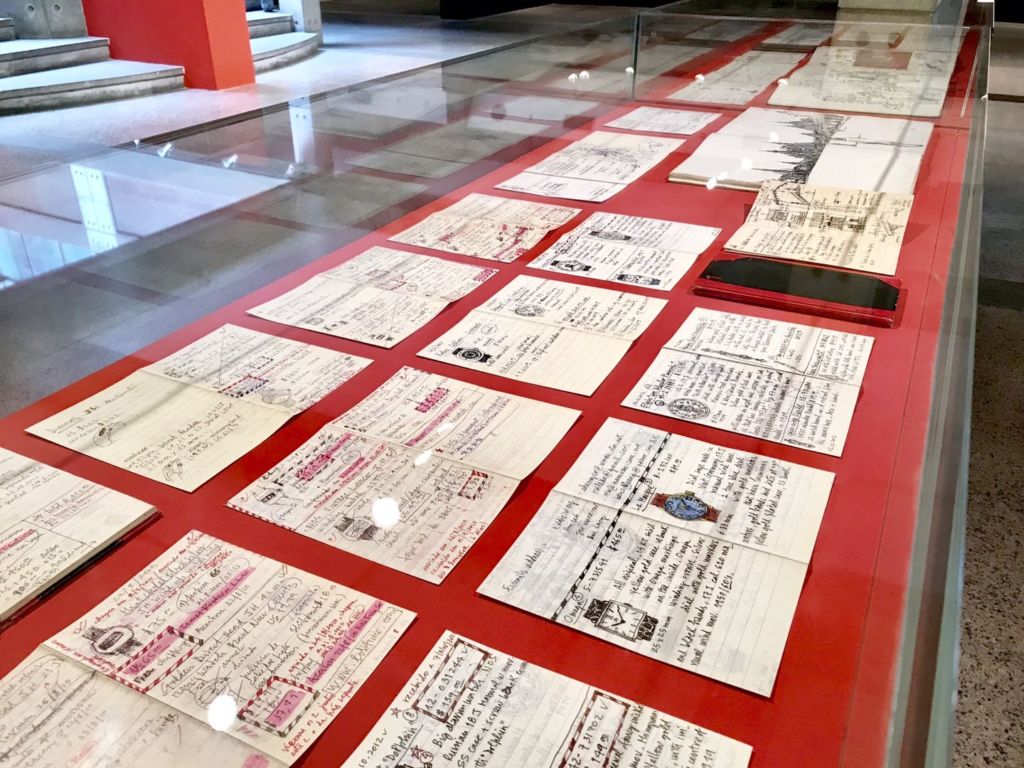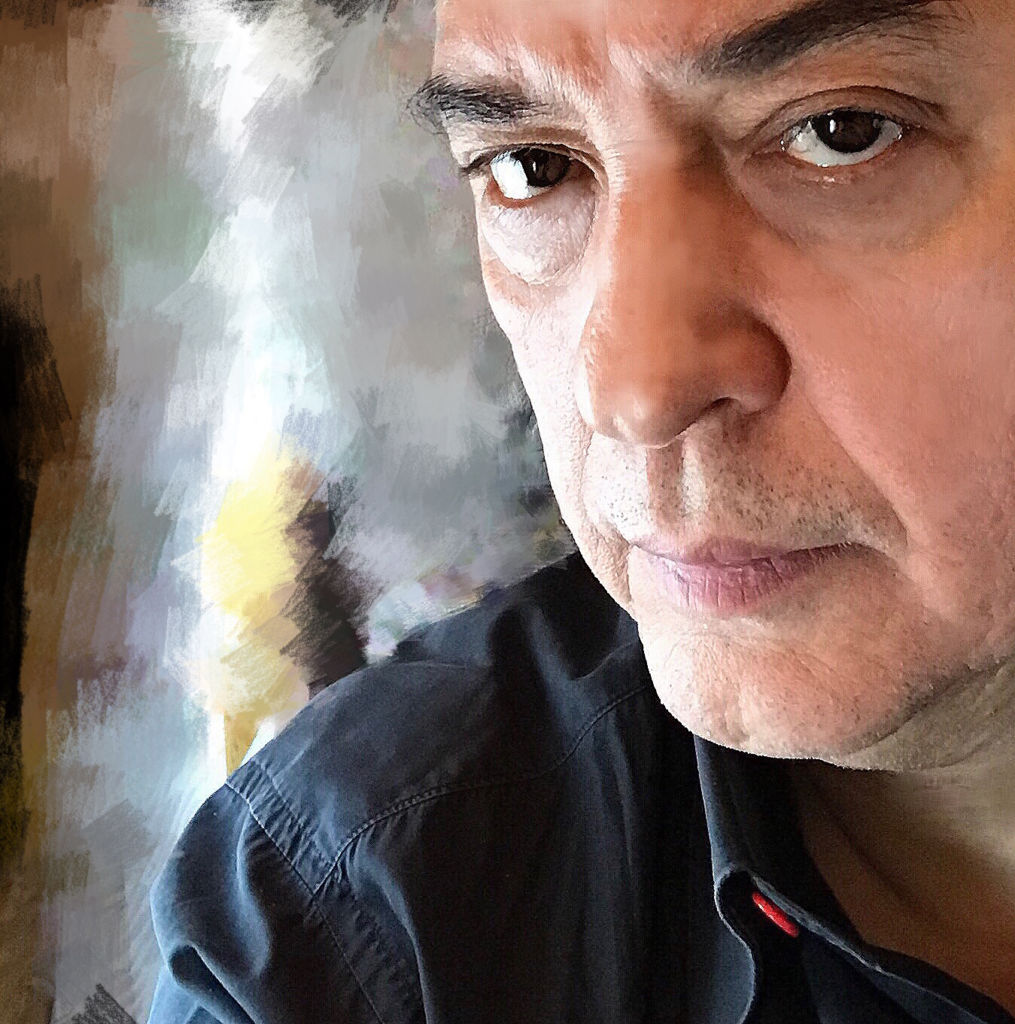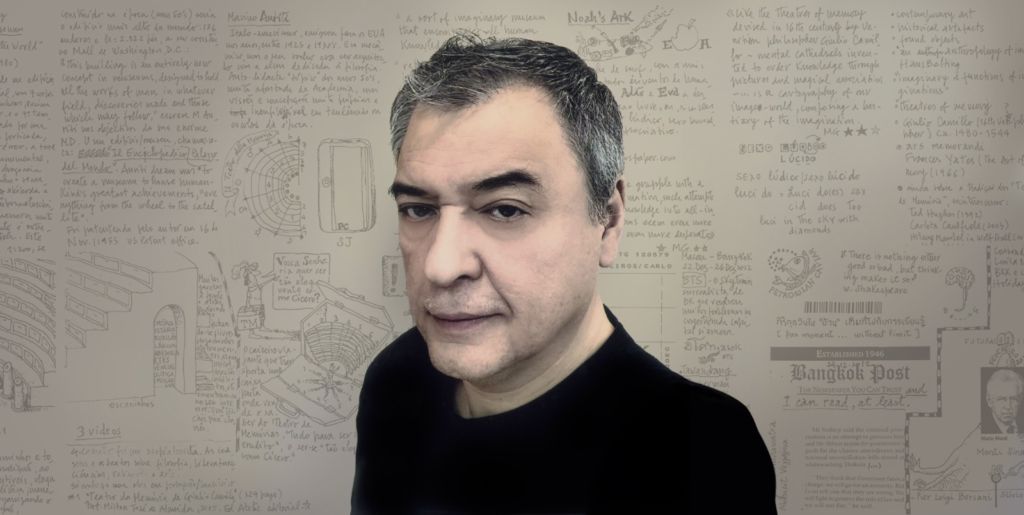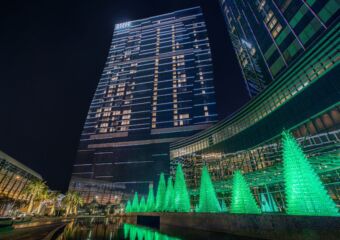Proud Macanese, cat lover, architect, urban planner, artist and with a palpable love for the city, Carlos Marreiros is no stranger to most of us. One of the most prominent artists in town, Carlos Marreiros represented Macau at the 55th Venice biennale, back in 2013 with his Pato.Men (which stands for Palace Theatre of Memory Encyclopedic). The artist is currently displaying several of his artworks through his exhibition Red December, including an extensive collection of intimate “logbooks” depicting notes and sketches where the visitor is allowed into his creative world, travels, and experiences. The exhibition features an outstanding composition named “Red December, Celebrations” which is filled with detail and depicts a scene where historical figures and famous people from different periods of time come together on a large ship.
Carlos Marreiros welcomed us at his exhibition Red December at Tap Seac Gallery, kindly guiding us through his artworks and speaking to us openly on various subjects such as the state of art, the city, and his own family.

Red December by Carlos Marreiros
In your Red December exhibition, we noticed that your travels influence your artwork. Do you always travel with your sketchbook ready to draw whatever your surroundings inspire you to?
Yes, I always travel with my notebooks and I call them “logbooks”, to be precise. But not only abroad. In Macau, every day is a journey, a trip, therefore I bring along my logbook and take notes of everything that interests me. Sometimes I’m at a meeting and draw on paper or if I read something interesting in the newspaper or a magazine, I tear it out and add it into my logbook. I also collect little labels from chocolates or things I like to eat or drink… everything; bus tickets, vaporetto in Venice or some interesting bus tickets from China for instance, or Vietnam, Prague or Moscow, tickets from museums and football matches too. So the answer is yes: abroad and in Macau.
Art Macao had its first edition this year. What are your thoughts on this event? What impact did it have on the city and its cultural scene?
I think Art Macao is a good attempt to internationalize the market of Macau art. As you know, Macau is home to fine artists, not many because its population is small in numbers, but since the Portuguese administration up to this moment with the Macao SAR government, culture has always been supported particularly arts. Artists have possibilities here.
But the Macau artists, especially the young artists, need a platform to internationalize. Therefore, Art Macao plays this role very well. However, Art Macao has a little quid pro quo. It is linked to the gaming industry, which is good as they bring in the funds and they perform this as an act of “mecenato”, or patronage, which is good. But some of the presented exhibitions are too much anchored to the art consultants hired mainly from Hong Kong. Art is a form of freedom, of elevation of spirits, as a way of qualifying life! However, there is a negative side to it as well.
Some of the curators who are referred to as art curators are actually art consultants and very business-oriented, bringing artists from abroad and maybe selecting some from Macau not with the aim of bringing up quality in Macau, but just to suit their commercial and market strategies. This is less positive.
On the other hand, I think this idea came from Dr. Alexis Tam, who is an art lover, and exerted his best efforts to develop this side of the arts. I believe that Mr. Leonel Leong also attempted to create or at least study in order to focus in the near future, a market of art. Not only contemporary art but also antiques, precious Impressionism paintings or even Romanticism, beaux-arts and so on–which is good. So what these two secretaries have been doing and promoting both the elevation of the quality of art and a possible market. And when we say market, it is, of course, with a commercial approach, which has my support anyway. Sharing this with the entertainment industry players is also a very good idea for Macau. I hope that in the future we cater a little more to the local artists and give them opportunities, especially those youngsters ones or those who are starting or in a preliminary stage of their careers.

Photo credit: Carlos Marreiros
How do you find art education in Macau? Are there growing opportunities for young artists?
There are growing opportunities but the state of art in art education hasn’t yet reached the level that I have been dreaming of. There are more institutions but they in a way–much like what happens in Europe–still aren’t building up and growing artists, but teachers of visual education instead. This is the problem. The faculty of arts throughout the world normally produce teachers of visual arts and not purely artists. Of course, there are some shifts in the US and even Europe regarding the training in the arts field. The artists trained by a faculty should have a theoretical, historical and cultural hub in the faculty that they have to work with established artists to develop their creative skills. In Macau, the way that art has been taught is still too conventional, too beaux-arts. It must suffer, I won’t say a tsunami, but a blow, or say a whistle, a sweet breeze moving around these art schools in order to upgrade their teaching level and curricula.
How important is it to make art reach the masses? What would you say is the role of art in life?
So, the role of art in life is like everything else in life. Arts elevate the spirit. Arts bring people into a higher stage of spiritual feeling. So when art doesn’t elevate the spirit of the individual and the population, then it is worth nothing. On the other hand, art, like science, medicine, technology, architecture, whatever, the ultimate goal of art is happiness for the people. This is something precious for me. Art can be about political protest, criticism of a system, this social dimension of art is very important. But the main, the first and ultimate reason for art is to promote happiness to everybody. So if this goal can be fulfilled by art I support that art can and should be reached by masses. Sometimes the artists complicate their speech a lot. They build up a too elaborate story for a simple situation and this makes people move away from arts. On the other hand, because art has been so focused on masses, today there are repetitions and digital art reproductions and art installations that normal people perceive as very easy and think everybody can do. People feel that they were, in a way, misled by some artists. Art is for everyone, but you have to go through a process. If anyone can be an artist, why do you need a school of arts? One cannot wake up one day and decide “From now on, I’m will be an artist”. Summing up, art for the masses? Very important. Education as the first step for everybody.
What are your thoughts on digital art and new forms of art?
Absolutely in favor! As long as it elevates the spirit I am in favor of every form of expression: digital, video, collage, every form of free expression of the spirit basically. As you can see, since the late 19th century up to World War II, in just less than seventy years, the changes in art were as much as in the last two thousand years. We are in the process of extremely fast-paced changes, therefore all ways of art are valid.
Macau holds a predominant role as a cultural exchange platform within the Greater Bay Area (GBA). What do you believe made the city fit for this position? Is it because of Macau’s rich history and inclusive society?
Yes, absolutely. Our very rich Chinese, Portuguese, Eastern and Western fusion of cultures made Macau’s past something so fantastic which is reflected in its architecture (recognized as World Heritage by UNESCO), cuisine, literature, the way of running businesses or even administration. So this is one of the strong factors that make Macau so interesting. There are designers, artists, architects, and writers as well that use this identity to transform it into a very contemporary and avant-garde approach. That is good but it is not enough because we are very small within an area that is quite huge, 55,000 square kilometers (GBA). But this GBA is not about its territory, but its people. With almost 70 million inhabitants, which is the size of the UK, seven times bigger than Portugal, and half the population of Canada, this raises other questions.
I am an architect and city planner so I’ve talked to my colleagues in the field and I know that if we don’t establish something very strong we may be swallowed by Guangdong or Shenzhen. Guangdong is also culturally and historically very rich. Hong Kong is not as culturally rich and neither is Shenzhen but Shenzhen in terms of productivity and creativity, they are a very strong, creative city. Therefore, we have to bet more on education, we have a good level of education but we have to do more. We have also to make Macau, specially Coloane island, an example of a green smart city with green energies for all public commodities like public and housing lighting and so on. Using water from the rain to irrigate the parks and valley. We waste a lot of potable water and as such, should be using the rainwater as well as the water from the river to serve these infrastructures. Having green planning in Coloane with very low housing and low density only for senior citizens and children and a university research institute, making Macau an example of a green city not only to the GBA but to the world.
On the other hand, doing a lot of research and putting together videos–not only books–with not a lot of wording as people have no time to read. But with a video, you can have very clever clips showing everything. We have to do this to showcase our culture, history, and inclusive society; how we embraced the refugees since the bygone times; how European people were so respected here; how Chinese expanded to the world through Macau, by Jesuits, traders, and travelers. All this using a very strong 5G infrastructure–Macau without 5G won’t survive the future.
You’re an artist and an architect. Do these two ever merge and how so?
All the time! Architecture has a very strong industry and business side to it. Of course, I will not make the life of the developer difficult. When a developer wants to build something he wants to have profit and we have to respect that and design the scheme in a way that enables his valuable investment to be profitable. On the other hand, the psychological and artistic sides of architecture, I always deliver and I convince them to bring that in. What I said before about the happiness of the people, with the same money, typological approach, and the same functional breath we can incorporate this so the spaces where people live in can be much happier!

Red December by Carlos Marreiros
When did your passion for art arise? What made you first feel drawn to it?
At a very young age, in fact. When I was in high school, 13 years old, I used to be selected to decorate the school for parties. Normally only older students would be invited to do so and I was invited very young to take part in this. In those times, half the teachers used to say “Carlos will be an artist, he has a hand for it!”. The other half would say I’d grow to be a lawyer because I had good logic and because I’d query a lot. I was good at drawing of course, but I was also good at maths, geometry, and science too. I was not very good in literature. Amazingly, I took an interest in literature in college while studying architecture. It was then that I started to love more and more literature, history, not in high school. Art was always with me.
My mother’s side of the family was very artistic too. Raul Xavier, one of the greatest Portuguese sculptors of the thirties, he was a cousin of my maternal grandfather. My maternal grandfather studied to become a priest but did not finish his studies. He was very good at writing poetry, drawing, and designing architecture. He was a musician too–he played the clarinet–but due to the difficulties of World War, my grandfather couldn’t develop in any of these and had to start working. He had 10 children. My mother was very good at drawing and my uncle too, but he pursued the real estate business. Me, my brother and other cousins we were happy to have the opportunity to study arts. My brother is also an artist. We were very fortunate. If I had to go back in time, I’d make exactly the same choices I did forty years ago.
This year marks the 20th anniversary of Macau’s handover. Having spent most of your life in the city, can you elaborate on Macau now and then? What are the main changes that you’ve noticed?
Macau has changed 180 degrees, because the sovereignty, the administration was managed by Portuguese and is now managed by local Chinese. On the other hand, nothing has changed as well because I still have freedom of spirit and expression, my life is as before and nothing objectively changed in terms of social politics and the political structures are more a less the same as they used to be. Of course, the city changed a lot. The lifestyle didn’t change so much. Now we have more buying power as salaries are much better. We have civil services department who are working very well and we are known in the world as a gaming paradise.
There are, however, other issues, such as the air quality, public transportation system, the chaotic traffic, and housing issues as they are too expensive for young people. This is the negative part of Macau. But at the end of the day, we go home and feel fantastic, secure, free and happy. My family and I decided, back in 1991, that we would stay in Macau because I trust the political word of China. I have no regrets at all. I have two daughters, one in Lisbon and one in London, maybe they’ll come back someday. But my and my wife are here with our cats and we are very happy. I’ll stay here until I close my eyes. I love this place!
Your ancestors have been based here for 200 years. Can you tell us about your family’s history?
I am Santos Marreiros. Dr. Jorge Forjaz, who is an expert in Macanese genealogy wrote that my grandfather’s side has a lot of blood mixture: Portuguese from Beira and North Portugal, Indian and Malay. But he looked very Caucasian! This dates back to the Qing dynasty, almost 200 years ago. My grandfather married a Chinese girl from Macau, she had origins in Cuiheng, the little town where Sun Yat Sen was born. So I used to joke that Sun Yat Sen is my godfather! But this is pure fun. Then, my mother was born. She is mixed. My mother, later on, married my father, who is from Lagos, South Portugal. My father’s side of the family is European. They had two sons, me and my younger brother Victor.
Back when I studied in Europe, I’d go to Italy and people would speak Italian to me, I’d go to Russia and people would speak in Russian to me. I don’t look very characteristic of one place so I can mingle around!
“Red December” – Exhibition by Carlos Marreiros

Organized by the Cultural Affairs Bureau, this exhibition opens to the public on November 8, at Tap Seac Gallery. This exhibition features artist Carlos Marreiros’ latest large-scale artwork “Red December” and a series of paintings from his sketchbooks. “Red December”, a large composition embedded with detail, depicts a scene where Chinese and Western historical figures from different periods of time gather together and indulge in pleasant conversations with each other.
The work visualizes the utopia in the artist’s mind, where different cultures exist harmoniously in an inclusive society. In addition, the paintings from his sketchbooks give an account of the artist’s creative and reflective processes over the years, allowing the audience to take a close look at his sources of inspiration and traverse his creative world which features both Chinese and Western cultures. “Red December” is on until February.
When: November 8, 2019–February 13, 2020
Where: Tap Seac Gallery, Praça do Tap Seac, Macau
How much: Free admission



































